Experimental Objective
The main objective of performing this experiment was to investigate the forces plying on a body resting on an inclined plane.
Theoretical Background
An inclined plane is a simple machine made up of a straight and a flat surface with two of its extreme edges set at different altitudes. This machine comes in handy when one is moving a heavy body over a given height. On using this machine to perform such tasks minimal energy is expended at the cost of an increased distance over which the body is to cover. Basically, the effort required to push the load over an inclined plane is proportional to the angle of inclination. Consequently, in order to expend less effort one should consider making the slope of the plane gentler.
When considering a frictionless inclined plane, the Mechanical Advantage (M.A), which is the ratio of load to effort, increases with decrease in the angle of inclination. This ratio can as well be obtained by taking the ratio of the effort distance to the load distance (Velocity Ratio, V.R). To obtain the efficiency of a machine, the ratio of M.A to V.R is obtained and then given as a percentage. Significantly, the efficiency of an incline plane increases with the decrease in the angle of inclination (Henderson 1989). For a frictionless inclined plane the efficiency is always 100%. However, in practice this is unattainable since other factors come in play to reduce the efficiency. One factor that decreases efficiency of an inclined plane is friction force that tends to drag motion between moving parts. Consequently, when resolving forces plying on a body resting on an inclined plane it is vital to consider:
- The normal force (N) which acts perpendicular to the inclined plane,
- The gravitational force or weight (W) acting vertically downwards,
- The frictional force (F) that acts along the inclined plane.
These are illustrated as shown in the figure below:
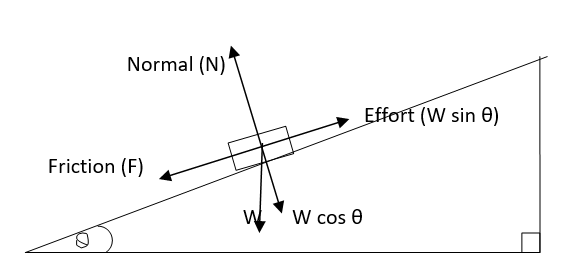
The gravitational force is decomposed into two components of forces, W cos θ and W sin θ, which act perpendicular and parallel to the inclined plane respectively. The former force is equivalent to the N (the normal reaction) while the later is equivalent to static friction when the body is stationary (Henderson 1989). As the angle of inclination reduces the normal reaction tends to approach the weight (mg) of the body. In the contrary, when this angle increases the normal reaction tends to approach zero.
Experimental Procedures
Amounting panel was secured vertically over which two pulleys; a plumb line and a sliding plane were mounted at a level. The plumb line was suspended at the centre screw of the protractor and made to pass over it to obtain the angle of inclination as shown in the figure below. Prior to this, the weights of the roller plus the hook were taken and recorded.
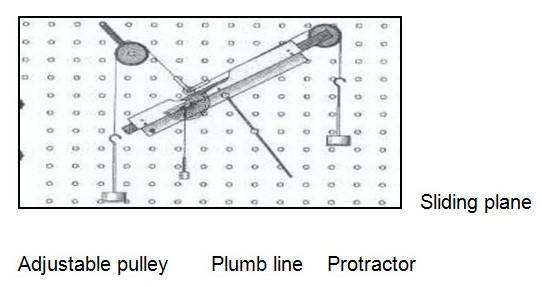
The sliding plane was set at an angle of 15° with the vertical plane courtesy of the plumb anterior pulley was weighted to just make the pulley start sliding down the plane. This value was recorded. Similarly, the same cord was weighted and the value of the weight that would just make the roller start sliding up the plane recorded. The average of these two values was obtained to find the pull supporting the roller. While maintaining the same weight on the first cord, the adjustable pulley with a cord over it was adjusted to meet the inclined plane at 90°. This cord was then weighted to the point of making the roller just clear off the surface of the plane. This value was later recorded for analysis. The same procedure was repeated for different values of theta (25°, 35° and 45°) for the purpose of analysis. line. Initially, a cord that was attached to a roller placed on the sliding plane and passing over the.
Experimental Data
Data Analysis
Theoretical values for the parallel component equivalent to the pull were obtained from the expression:
F= W sin θ
Therefore for 15°; F= 2 sin 15°
= 0.5 N
The same approach was used to obtain the resulting forces due to the other remaining angles.
Theoretical values for the vertical component equivalent to normal reaction were obtained from the expression:
F = W cos θ
Therefore for 15°; F = 2 cos 15°
= 1.93 N
The same approach was used to obtain the other forces due the other remaining angles.
The triangle of forces diagrams for the four tests are illustrated as below:
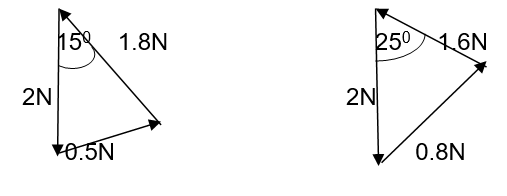
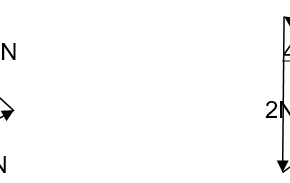
As regards the relationship between the angle of inclination and the weight acting on it, the plot assumes an inverse relationship as shown below:
Graph of the Normal reaction N against the angle of inclination for both the theoretical and practical data.
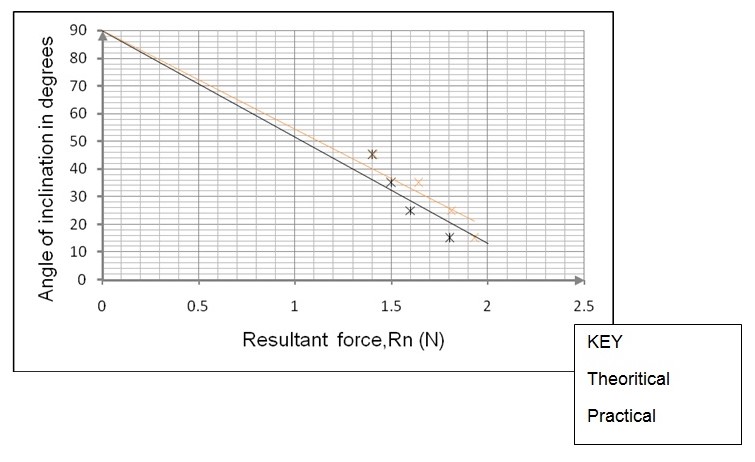
Discussion
The objective of this experiment was to investigate the forces acting on a body resting on an inclined plane. From this experiment it can be deduced that with respect to bodies resting on an inclined plane, there are three forces that act on them. These forces are:
- Frictional force,
- Normal reaction force,
- The weight of that body.
These are the forces that maintained the roller at apparently stationary position clearly above the inclined surface. The graph of the angle of inclination against the resultant force (Rn) perpendicular to the inclined surface demonstrated an inverse relationship. This indicates that more weight is felt on the surface of the inclined plane when it approaches the horizontal line. This principle is significant in understanding the impact of a flattening roller on a steep hill. Basically, the efficiency of a flattening roller decreases with the increase in slope of a given surface. The plots obtained for the theoretical and the practical data had a common trend though the slopes obtained for the same were contrary to our expectations. We expected the theoretical slope to be steeper than the practical one because the former does not take into account the energy losses due to friction of the moving parts. This uncertainty might have been caused by the assumptions made on the value of gravity (g) when calculating the weight. This can be minimized by finding the value of g prior to the calculations.
Conclusions
In a conclusion, the objective of the experiment was achieved since the forces acting on an inclined plane were identified and a correlation drawn between them by altering the angles of inclination. Generally, the impact of weight on an inclined plane decreases with the increase in slope and as such, the efficiency of a flattening roller decreases with steepness of the surface.
References
Henderson, T. Motion and Forces in Two Dimensions. Web.